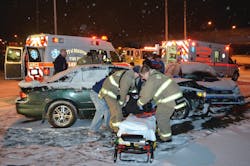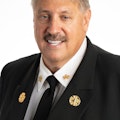Some years ago, when I was working in St. Louis, MO, I was doing research about the city’s police department for a project I was working on. While doing the research, I came across a book the department publishes that details the deaths of the 171 St. Louis police officers who have been killed in the line of duty. While reading the book, I was shocked to see that at least 15 city police officers were hit and killed by streetcars.
Before the proliferation of the traffic light, police officers would stand at major intersections and direct traffic. Unfortunately, sometimes they would step into the path of a streetcar that ran on rails like the San Francisco cable cars do now. Roadways and highways have for many years been the scenes of the deaths of many firefighters, paramedics and police officers.
Happens all too often
Anybody who has worked a motor vehicle accident, car fire, grass fire or any other incident on a highway knows what I am talking about. Many times, you’re thankful you got back to the station safe. You can wear all the bright-fluorescent vests you want, set up cones, put chevrons on the back of vehicles, use apparatus to block the scene or employ other alerting devices, but there is still going to be drivers who are not paying attention because they are texting, thinking about the meeting they just came from or diverted by some other thoughts that will allow them to run into your scene.
Unfortunately, I read too often of one of our own who are killed on highways.
The Dayton Daily News in Ohio recently ran the story of a city fire captain who recounted getting hit by an out-of-control pickup truck that struck him and threw him through the air. The whole incident was captured on the dash cam of a police car as the captain was checking on another person who had just lost control of a vehicle. As happens on videos from police dash cams you see of highway accidents involving public safety personnel, there was little or no warning of the impending crash. The captain said he had less than one second’s warning that he was going to be thrown through the air after hearing the skidding of tires. He suffered three broken ribs and a fractured leg, along with bruises. He is fortunate to be able to tell his story.
Several days after the Dayton fire captain was struck, a New Jersey Forest Service firefighter was struck and killed along a highway because of reduced visibility due to heavy smoke from a wildland fire. Some firefighters have even been forced to decide whether to be hit by a car or jump off a bridge. In February, a Windsor, Vermont firefighter jumped off a bridge on I-95 to avoid getting hit by an out-of-control tractor-trailer truck. Molly Woods, a four-year firefighter, jumped approximately 25 to 30 feet to avoid being hit by the truck. She suffered a concussion, cuts and bruises and a broken ankle.
Last February, a City of Alexandria, VA, firefighter/paramedic fell to his death when he climbed over a guardrail to get to the other lanes of the highway where a car was burning. There was a three-foot gap between the two guardrails for each side of the highway and he fell approximately 20 to 30 feet to a creek below.
I am actually surprised we have not seen multiple deaths of firefighters on a single highway accident. If you think about how many firefighters are operating on a highway during any single event, if would not be unreasonable to believe that multiple firefighters could be killed at the same time. Unfortunately, this almost happened in March, when six members of the Hudson Fire Department in Illinois were injured, one fatally, as they worked an accident on a snowy interstate highway. Firefighters were working a multiple-vehicle accident on Interstate 39 at night when a tractor-trailer truck carrying automobiles lost control and struck three emergency vehicles belonging to the Hudson Fire Department and the Illinois State Police.
I dread the day when we will hear that multiple public safety providers have died in a highway accident.
Here’s one true way of avoiding as many deaths as possible on a highway or roadway for firefighters – completely shut down the highway! Of course, this would probably anger many drivers and I have been stuck in those traffic jams before where everything is at a complete standstill. They’re no fun when you have somewhere to be.
The solution is to employ the procedures we have in place now. Don’t hesitate to use multiple apparatus to block a scene, especially when there are snow or ice conditions. Instead of one rig, call for several more. You can also find lots of information about highway safety at www.respondersafety.com. (Also see Dr. Harry R. Carter’s blog “We Must Take Care of Our Troops on Highways” on Firehouse.com.)
Although we are making headway in reducing firefighter deaths, we still have a long way to go. Eliminating firefighter fatalities on highways and roadways will certainly help us get us there.
For more news and training on EMS, visit http://EMSWorld.com/.
GARY LUDWIG, a Firehouse® contributing editor, has 35 years of fire, rescue and EMS experience. He currently serves as a deputy fire chief for the Memphis, TN, Fire Department. Ludwig is also chair of the EMS Section for the International Association of Fire Chiefs. He can be reached through his website at garyludwig.com.
About the Author
Gary Ludwig
GARY LUDWIG has served in three fire departments over his career: St. Louis, Memphis, and Champaign, IL. His fire, EMS and rescue career spanned a total of 46 years, and he has been a paramedic for over 44 years. Ludwig served as president of the International Association of Fire Chiefs in 2019-20. He has a Master’s degree in Business and Management, has written over 500 articles for professional fire and EMS publications and is the author of seven books.
Connect with Gary
Email: [email protected]
Facebook: Gary Ludwig
Twitter: @ChiefGaryLudwig
Website: garyludwig.com

